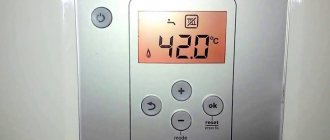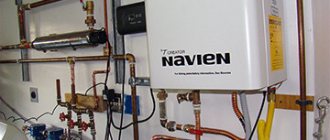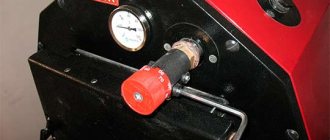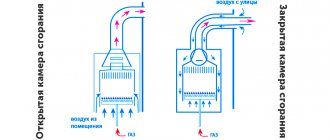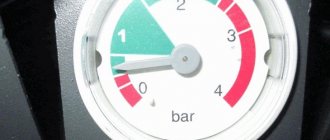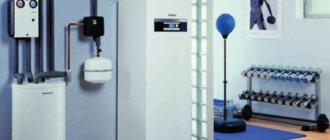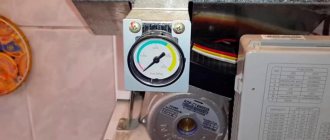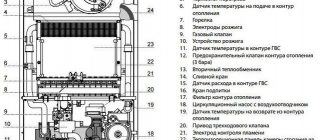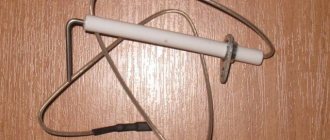With the onset of cold weather, the question increasingly arises on thematic forums about what temperature to set on the heating boiler. After all, owners want to achieve a comfortable temperature in their home, but at the same time not pay extra for heating. Of course, there are no exact values here, but we will try to give general recommendations.
Let's say right away that the temperature regime will depend on the weather conditions outside, the quality of insulation of the house, the type and quality of windows in the house, as well as a number of other objective factors that need to be taken into account. Therefore, we cannot say that all our recommendations will suit you personally. However, we must share them.
Installing a thermostat
Another reason for the frequent switching on and off of a gas heating boiler is that the operation of the equipment is regulated only by the temperature of the coolant.
The water heated up to the required temperature, the device turned off, the water cooled, the boiler turned on. But the coolant cools much faster than the air in the room. Such management is not rational, since it increases fuel costs, the rooms can be hot, which, of course, will affect the comfort of residents. The best way out of this situation is to install a room thermostat. The device is designed for automatic control of a gas boiler. The operation of the heating unit becomes more efficient, and it is possible to save on fuel. The system starts only when the air temperature in the room drops, and it can remain at this level as a result of sunlight entering the room or a crowd of people in the room.
The range of thermostats allows you to choose a model in accordance with your wishes and financial capabilities. The cheapest are mechanical products. They do not require special treatment and are durable and reliable. Much more difficult with modern programmers. These are devices that can be programmed, set certain options, set different temperatures depending on your needs.
For the efficient and economical functioning of the heating system, care should be taken to carry out the installation work correctly. You won't have to worry about how often your heating boiler should turn on if its operation is controlled by a thermostat. This will not only save on fuel, but will also extend the life of the heating equipment.
What’s better: setting up the boiler yourself or calling a specialist?
Setting up a boiler is a difficult task, but quite feasible. In this matter, you need to understand and take into account many factors, the main one of which is safety. It is important to understand that this equipment runs on gas. When working with it, special care and caution will be required.
When you just need to configure the programmer, choosing the desired mode is not difficult. And if there is a need to get into the boiler structure and disassemble it, it is better to use the services of a specialist.
Ways to reduce heat loss
The above information will help to be used to correctly calculate the coolant temperature norm and tell you how to determine situations when you need to use a regulator.
But it is important to remember that the temperature in the room is affected not only by the temperature of the coolant, street air and wind strength. The degree of insulation of the facade, doors and windows in the house should also be taken into account
To reduce heat loss from your home, you need to worry about its maximum thermal insulation. Insulated walls, sealed doors, and metal-plastic windows will help reduce heat loss. This will also reduce heating costs.
The efficiency of a heating system depends on many factors. These include rated power, heat transfer rate of radiators and operating temperature conditions
For the last indicator, it is important to correctly select the degree of heating of the coolant. Therefore, it is necessary to determine the optimal temperature in the heating system for water, radiators and boiler
Burner flame
One of the indicators of proper burner operation is the color of the flame. Gas equipment is characterized by an even bluish flame without admixtures of other colors. The presence of yellow or red splashes indicates that the burner is not working well, which reduces the efficiency of the heating equipment.
First of all, this applies to injection burner devices, but sometimes it is also typical for fan burners. The flame may simply lack oxygen. Also, dust and other small debris can get in with the air, which will clog the device, reducing the efficiency of the boiler. All this directly affects the flame. If it hums, the burner is loud, or the fire has changed color, you need to adjust the correct operation of the device.
Removing air from the heating system of a solid fuel boiler.
Air in the heating system can cause a number of problems: poor circulation of coolant or its absence, noise during pump operation, corrosion of radiators or heating system elements. To avoid this, it is necessary to bleed the air from the system. There are two ways to do this - the first is manually - we think about installing valves at the highest point of the system and on lifting sections and periodically pass these valves, releasing air. The second way is to install an automatic air release valve. The principle of its operation is simple - when there is no air in the system, the valve is filled with water and the float is located at the top of the valve, and, through a hinged lever, seals the air outlet valve.
When air enters the valve chamber, the water level in the valve drops, the float lowers and, through a hinged lever, opens the air release hole on the outlet valve. As air leaves the chamber, the water level rises and the valve returns to the upper position.
We have already described the design of the boiler safety group above when we talked about protection against high coolant pressure. Ideally, if you have installed a safety group, it has an automatic air release valve. Just make sure that the safety group is installed at the top of your heating system. If not, we recommend installing a separate automatic air release valve and forever solving the problem of finding air pockets in your heating system.
Solid fuel boiler piping - Automatic air release valve
Heat supply of a multi-storey building
Heating distribution unit for an apartment building
Heating distribution in a multi-storey building is important for the operational parameters of the system. However, in addition to this, the characteristics of the heat supply should be taken into account
An important one is the method of supplying hot water - centralized or autonomous.
In most cases, a connection is made to the central heating system. This allows you to reduce the current costs in the estimate for heating a multi-storey building. But in practice the level of quality of such services remains extremely low. Therefore, if there is a choice, preference is given to autonomous heating of a multi-storey building.
Autonomous heating of a multi-storey building
autonomous heating of a multi-storey building
In modern multi-storey residential buildings, it is possible to organize an independent heat supply system. It can be of two types - apartment-based or communal. In the first case, the autonomous heating system of a multi-storey building is carried out in each apartment separately. To do this, make independent piping and install a boiler (most often a gas one). A common house installation involves the installation of a boiler room, which has special requirements.
The principle of its organization is no different from a similar scheme for a private country house. However, there are a number of important points to consider:
- Installation of several heating boilers. One or more of them must perform a duplicate function. If one boiler fails, another must replace it;
- Installation of a two-pipe heating system of a multi-storey building, as the most efficient;
- Drawing up a schedule for scheduled repairs and maintenance work. This is especially true for heating heating equipment and safety groups.
Taking into account the peculiarities of the heating scheme of a particular multi-storey building, it is necessary to organize an apartment-by-apartment heat metering system. To do this, energy meters must be installed on each incoming pipe from the central riser. That is why the Leningrad heating system of a multi-storey building is not suitable for reducing operating costs.
Centralized heating of a multi-storey building
Elevator unit diagram
How can the heating distribution in an apartment building change when it is connected to a central heating supply? The main element of this system is the elevator unit, which performs the functions of normalizing coolant parameters to acceptable values.
The total length of the central heating mains is quite large. Therefore, at the heating point, such coolant parameters are created so that heat losses are minimal. To do this, increase the pressure to 20 atm. which leads to an increase in the temperature of hot water to +120°C. However, given the characteristics of the heating system in an apartment building, supplying hot water with such characteristics to consumers is not permitted. To normalize the parameters of the coolant, an elevator unit is installed.
It can be calculated for both a two-pipe and a single-pipe heating system in a multi-storey building. Its main functions are:
- Reducing pressure using an elevator. A special cone valve regulates the volume of coolant flow into the distribution system;
- Reducing the temperature level to +90-85°C. A mixing unit for hot and cooled water is designed for this purpose;
- Filtration of coolant and reduction of oxygen content.
In addition, the elevator unit performs the main balancing of the single-pipe heating system in the house. For this purpose, it is equipped with shut-off and control valves, which automatically or semi-automatically regulate pressure and temperature.
You also need to take into account that the estimate for centralized heating of a multi-story building will differ from autonomous heating. The table shows the comparative characteristics of these systems.
Optimal values in an individual heating system
Autonomous heating helps to avoid many problems that arise with a centralized network, and the optimal temperature of the coolant can be adjusted according to the season. In the case of individual heating, the concept of standards includes the heat transfer of a heating device per unit area of the room where this device is located. The thermal regime in this situation is ensured by the design features of the heating devices.
It is important to ensure that the coolant in the network does not cool below 70 °C. 80 °C is considered optimal
With a gas boiler, it is easier to control heating, because manufacturers limit the ability to heat the coolant to 90 °C. Using sensors to regulate the gas supply, the heating of the coolant can be adjusted.
It is a little more difficult with solid fuel devices; they do not regulate the heating of the liquid, and can easily turn it into steam. And it is impossible to reduce the heat from coal or wood by turning the knob in such a situation. Control of heating of the coolant is quite conditional with high errors and is carried out by rotary thermostats and mechanical dampers.
Electric boilers allow you to smoothly regulate the heating of the coolant from 30 to 90 °C. They are equipped with an excellent overheat protection system.
Each season has its own regime
Modern boilers are very easy to adjust a variety of parameters, including the intensity of fuel combustion. This function was introduced for a reason, but to prevent excessive fuel consumption due to clocking. It is recommended to choose your own regime for each season:
- Winter - maximum or average power.
- Spring, autumn - minimum power, in March and November - average.
- Summer - the boiler is not used, or - minimum flame.
However, these settings are relevant if the boiler matches the size of the heated room. Many people take equipment “with a reserve” of power, implying severe frosts, deterioration of the heat-saving properties of housing, or an increase in the area of the premises. In this case, it is recommended to immediately set the flame to minimum, especially if the boiler is wall-mounted.
Burner adjustments may stop working or operate incorrectly over time. If boiler repair is not possible, you can change the flame power using a valve on the gas pipe. This method is rarely used in practice, since valve wear can lead to leaks.
What temperature to set in the heating boiler: low and high values
Let us share our experience regarding different temperature conditions.
- 40 degrees.
This regime often turns out to be economically unprofitable. At this temperature, a gas boiler may well underheat to half a degree. Because of this, the circulation pump and heating do not turn off. Accordingly, gas consumption only increases. In some boiler models, the flow rate may be even higher than at the set temperature of 70°C. In addition, it is better to refuse such a temperature regime in cases of unstable operation of the electrical network. The coolant will cool down in a short time, the room will become cold within a few hours. - 50 degrees.
Most tests show that gas flow is lowest when this temperature is set. However, the circulation pump runs for quite a long time, which increases electricity costs. Plus, in case of power outages, the batteries retain heat a little longer. In general calculations, this mode of system operation is less economical than the next one. - 60 degrees.
This is rightfully the most economical mode. More gas is required than in the 50-degree mode, but electricity costs are noticeably reduced. Total costs are lower. And the room is heated better. - 70 degrees.
In this mode, less electricity is consumed, but gas consumption increases. But a more important problem is that with some boiler models, in this mode of operation, fluctuations in the air temperature in the room are possible. They can be either practically invisible or quite noticeable. The fact is that radiators continue to strongly heat the rooms even after the heating in the boiler is turned off, then they cool down, then they become very hot again.
Setting the temperature even higher is not a good idea unless you live in cold northern regions. And there are several reasons for this. The main thing is that such high temperatures are simply not needed in the house. And even if you need to heat the rooms as much as possible, it is better to set the temperature lower. If the values are too high, an unpleasant smell of burning dust from the batteries appears, and polypropylene pipes wear out faster.
So what temperature should the heating boiler be? We recommend around 60-65 degrees if the outside temperature is not lower than -10°C. If lower, you can increase the power. If it's near zero outside, you won't need more than 50-55 degrees.
What temperature on the boiler is optimal for heating without a difference in room temperatures?
Often, the most important thing for a homeowner is not savings, but uniform heating of all rooms in the house. The boiler operates continuously, preventing the temperature from falling below the selected value. Of course, this mode requires more electricity, but you can save on gas.
40 degrees is not always enough for comfortable and uniform heating. With this mode, the house will warm up by an average of 20-20.5 degrees at an outside temperature of at least -9°C. If twenty degrees in the room is not enough for you, you can set 45-50 degrees on the boiler.
How to save on gas heating
The desire to spend as little as possible on heating is quite natural.
When using gas, there are several ways to save fuel:
- Installation of a gas flow meter. The problem is very relevant, since in the absence of a meter, the resource supplying organization will charge the consumer not for the specific volume of fuel consumed, but according to regional standards. The difference can be up to 2-3 times.
- Reduced heat loss. For example, a private house can lose up to 25% of heat through the roof, up to 25% through windows, up to 35% through walls, and up to 3% through a door.
- Maximum use of automation equipment. Automation will monitor the necessary parameters better than a human.
- Increasing the efficiency of equipment operation. For example, replacing an old-style burner with a more modern version can save up to 5% of gas.
- Application of new means of ventilation. These include recovery systems - this is when the exhaust pipe of a gas boiler through the wall of the house passes inside the supply ventilation pipe. Outside the house, the exhaust pipe raises the exhaust gases much higher, and the cold air from the street enters the house already slightly warmed up. The use of a recuperator allows you to save 5-10% of the volume of gas consumed.
Temperature standards
Requirements for coolant temperature are set out in regulatory documents that establish the design, installation and use of engineering systems of residential and public buildings. They are described in the State Building Codes and Rules:
- DBN (V. 2.5-39 Heat networks);
- SNiP 2.04.05 “Heating, ventilation and air conditioning.”
For the calculated supply water temperature, the figure is taken that is equal to the water temperature at the outlet of the boiler, according to its passport data.
For individual heating, deciding what the coolant temperature should be should take into account the following factors:
- The beginning and end of the heating season based on the average daily outdoor temperature of +8 °C for 3 days;
- The average temperature inside heated premises of housing, communal and public importance should be 20 °C, and for industrial buildings 16 °C;
- The average design temperature must comply with the requirements of DBN V.2.2-10, DBN V.2.2.-4, DSanPiN 5.5.2.008, SP No. 3231-85.
According to SNiP 2.04.05 “Heating, ventilation and air conditioning” (clause 3.20), the coolant limit values are as follows:
- For a hospital - 85 °C (excluding psychiatric and drug departments, as well as administrative or domestic premises);
- For residential, public, and domestic buildings (not counting halls for sports, trade, spectators and passengers) - 90 ° C;
- For auditoriums, restaurants and production premises of categories A and B – 105 °C;
- For catering establishments (excluding restaurants) it is 115 °C;
- For production premises (categories B, D and D), where flammable dust and aerosols are emitted – 130 °C;
- For staircases, lobbies, pedestrian crossings, technical premises, residential buildings, production premises without the presence of flammable dust and aerosols – 150 °C.
Depending on external factors, the water temperature in the heating system can be from 30 to 90 °C. When heated above 90 °C, dust and paintwork begin to decompose. For these reasons, sanitary standards prohibit greater heating.
To calculate optimal indicators, special graphs and tables can be used, which define standards depending on the season:
- With an average reading outside the window of 0 °C, the supply for radiators with different wiring is set at 40 to 45 °C, and the return temperature at 35 to 38 °C;
- At -20 °C, the supply is heated from 67 to 77 °C, and the return rate should be from 53 to 55 °C;
- At -40 °C outside the window, all heating devices are set to the maximum permissible values. On the supply side it is from 95 to 105 °C, and on the return side it is 70 °C.
Adjustment features
The parameters of heating routes are the responsibility of the management of thermal power plants and heating networks. At the same time, housing office employees are responsible for the network parameters inside the building. Mostly, residents' complaints about the cold concern deviations to the lower side. Much less common are situations where measurements inside thermal units indicate an increased return temperature.
There are several ways to normalize system parameters that you can implement yourself:
- Reaming the nozzle. The problem of lowering the temperature of the liquid in the return can be solved by expanding the elevator nozzle. To do this, you need to close all the gates and valves on the elevator. After this, the module is removed, its nozzle is pulled out and drilled out 0.5-1 mm. After assembling the elevator, it is started to bleed air in the reverse order. It is recommended to replace the paronite seals on the flanges with rubber ones: they are made to the size of the flange from a car inner tube.
- Silence the suction. In extreme cases (during the onset of extremely low frosts), the nozzle can be completely removed. In this case, there is a danger that the suction will begin to act as a jumper: to prevent this, it is turned off. For this, a steel pancake with a thickness of 1 mm is used. This method is emergency, because this can cause a jump in battery temperature to +130 degrees.
- Difference control. A temporary way to solve the problem of temperature rise is to adjust the differential with an elevator valve. To do this, it is necessary to redirect the DHW to the supply pipe: the return pipe is equipped with a pressure gauge. The inlet valve of the return pipeline is completely closed. Next, you need to open the valve little by little, constantly checking your actions with the readings of the pressure gauge.
A simply closed valve can cause the circuit to stop and defrost. A reduction in the difference is achieved due to an increase in return pressure (0.2 atm/day). The temperature in the system must be checked every day: it must correspond to the heating temperature schedule.
Model examples
- Baxi.
The optimal operating mode of this wall-mounted gas boiler is achieved as follows: in small apartments the indicators are set to F08 and F10. The modulation spectrum starts at 40% of the highest power. And the minimum possible operating mode is 9 kW.
Many models of this company are very economical and can operate at low gas pressure. Pressure limits: 9 – 17 mbar. Suitable voltage range: 165 – 240 V.
- Vaillant.
Many devices of this brand work optimally under the following conditions: power - 15 kW. The feed is set at 50-60. The device works for 35 minutes, rests for 20 minutes.
- Ferroli.
The best conditions: 13 kW for heating, 24 kW for water heating.
- Mercury.
Water pressure in the network is maximum 0.1 MPa. The highest temperature indicator at the outlet section is 90 C, the nominal value of the flue gases is at least 110 C. The vacuum behind the apparatus is a maximum of 40 Pa.
- Navien.
Basically, these are two-circuit units. Automation works here. The mode is customizable. The room heating parameter is set. There is a pump that can reduce parameters by 4-5 degrees.
- Ariston.
Automatic setting of modes also works. Often people choose models with the Comfort Plus mode.
- Buderus.
The following values are usually set on the feed: 40 - 82 C. The current parameter is usually reflected on the monitor. The most convenient summer mode is at 75 C.
Protection against low coolant temperature in the return of a solid fuel boiler.
What will happen to a solid fuel boiler if its return temperature is below 50 °C? The answer is simple - a tarry coating will appear on the entire surface of the heat exchanger. This phenomenon will reduce the performance of your boiler, make it much more difficult to clean, and most importantly, can lead to chemical damage to the walls of the boiler heat exchanger. To prevent such a problem, it is necessary to provide appropriate equipment when installing a heating system with a solid fuel boiler.
The task is to ensure the temperature of the coolant that returns to the boiler from the heating system at a level not lower than 50 °C. It is at this temperature that the water vapor contained in the flue gases of a solid fuel boiler begins to condense on the walls of the heat exchanger (transition from a gaseous state to a liquid one). The transition temperature is called the “dew point”. The condensation temperature directly depends on the moisture content of the fuel and the amount of hydrogen and sulfur formations in the combustion products. As a result of a chemical reaction, iron sulfate is obtained - a substance useful in many industries, but not in a solid fuel boiler. Therefore, it is quite natural that manufacturers of many solid fuel boilers remove the boiler from warranty if there is no return water heating system. After all, here we are not dealing with the burning of metal at high temperatures, but with chemical reactions that no boiler steel can withstand.
The simplest solution to the problem of low return temperature is to use a thermal three-way valve (anti-condensation thermostatic mixing valve). The thermal anti-condensation valve is a thermomechanical three-way valve that ensures the admixture of coolant between the primary (boiler) circuit and the coolant from the heating system in order to achieve a fixed boiler water temperature. In essence, the valve releases the coolant that has not yet been heated in a small circle and the boiler heats itself. After reaching the set temperature, the valve automatically opens the coolant to the heating system and operates until the return temperature again drops below the set values.
Solid fuel boiler piping - Anti-condensation valve
Ways to reduce heat loss
The above information will help to be used to correctly calculate the coolant temperature norm and tell you how to determine situations when you need to use a regulator.
But it is important to remember that the temperature in the room is affected not only by the temperature of the coolant, street air and wind strength. The degree of insulation of the facade, doors and windows in the house should also be taken into account
To reduce heat loss from your home, you need to worry about its maximum thermal insulation. Insulated walls, sealed doors, and metal-plastic windows will help reduce heat loss. This will also reduce heating costs.
Servicing a gas boiler with low performance is expensive. Therefore, anyone who uses such a device wants to find the optimal operating mode for the gas boiler
, at which it will have the highest possible efficiency (efficiency factor) with minimal fuel consumption. This problem becomes especially relevant on the eve of the next heating season.
The performance of a gas boiler is influenced by various factors. If you have not yet purchased this device, but are just planning to purchase it, please note that the main condition for its installation is the presence of a centralized gas supply. Some people think that they can get by with bottled gas, but this will significantly increase costs. In this case, it is better to install electric heating.
Optimal performance
depends on the following criteria:
- Boiler designs - they can be single-circuit, double-circuit, mounted, floor-mounted, etc.
- Efficiency – nominal and real.
- Proper organization of heating in the house: the power of the boiler must correspond to the area of the heated premises.
- Technical condition of the equipment.
- Gas quality.
Now let's take a closer look at how each of the criteria can be optimized to achieve maximum device performance.
Boiler design
Boilers are single-circuit and double-circuit. For the first one, you will have to purchase an indirect heating boiler so that it can heat the water. The double-circuit option is preferable, as it is equipped with everything necessary for producing hot water and heating the house. For ease of use, the priority mode in such a boiler is hot water supply. This means that when the water supply is turned on, the heating stops.
There are wall-mounted and floor-mounted gas boilers. The former have less power and can only heat a room up to 300 m². If your home is larger, you will need to purchase another wall mounted or floor standing boiler.
Nominal and real efficiency
The instructions for any gas boiler indicate the nominal efficiency, usually it is 92-95%, for condensing models it is about 108%. However, the real figure is usually 9-10% lower. It is further reduced by the presence of various types of heat loss:
- Physical underburning - this indicator depends on the volume of excess air present in the unit during gas combustion. It is also affected by the temperature of the flue gases: the higher it is, the lower the efficiency of the boiler.
- Chemical underburning - this indicator fluctuates depending on the volume of carbon monoxide that appears from the combustion of carbon.
- Heat loss that escapes through the walls of the boiler.
You can increase the real efficiency of the device in the following ways:
- Reducing the rate of physical underburning by regularly cleaning soot on the pipeline and removing scale from the water circuit.
- Reducing the amount of excess air by installing a draft limiter on the chimney pipe.
- By adjusting the position of the blower damper so that the maximum coolant temperature is achieved.
- Regular cleaning of soot from the combustion chamber, which increases gas consumption.
Replacing the chimney with a more innovative one will increase the efficiency of a gas boiler. Most traditional outlet pipes are too dependent on weather conditions. They were replaced by a coaxial chimney, which is resistant to temperature changes and can increase efficiency and also save fuel.
What happens when hot water is turned on simultaneously at two points of intake
The scheme becomes more complicated if, while using hot water at one point of intake, it becomes necessary to turn it on at another point, for example: when the shower is turned on in the bathroom, it becomes necessary to wash your hands in the toilet washbasin. In this case:
- the rate of hot water use increases sharply, its consumption increases,
- weak pressure of hot water appears;
- the flow of cold water into the boiler increases,
- a drop in the temperature of the boiler heat exchanger leads to the fact that the water temperature at the first intake point ceases to be comfortable,
- a few seconds are required to turn on the boiler automation for heating,
- a few more seconds for both users at two points of collection to be able to use water at a comfortable temperature.
All this time, both users cannot fully use hot water. It arrives intermittently. The unproductive consumption of water, which goes uselessly into the sewer system, increases sharply.
What if one of the users turned off the water? In this case, the consumption of hot water drops sharply. A temperature jump occurs on the heater of a double-circuit gas boiler. As a result, the temperature of hot water increases sharply at the point of intake that continues to operate. The user cannot fully use the water; it goes down the drain until the automation on the boiler is activated and water at the required temperature begins to flow to the user in a stable manner.
Since such situations are repeated several times every day, the unproductive consumption of hot water increases every day. At the same time, we should not forget about the discomfort that users experience when the supply of hot water is unstable.
Coordination of coolant and boiler temperatures
Regulators help coordinate the temperature of the coolant and the boiler. These are devices that create automatic control and adjustment of return and supply temperatures.
The return temperature depends on the amount of liquid passing through it. Regulators cover the liquid supply and increase the difference between the return and supply to the level required, and the necessary indicators are installed on the sensor.
If the flow needs to be increased, a boost pump can be added to the network, which is controlled by a regulator. To reduce the heating of the supply, a “cold start” is used: that part of the liquid that has passed through the network is again transported from the return to the inlet.
The regulator redistributes the supply and return flows according to the data collected by the sensor, and ensures strict temperature standards for the heating network.
